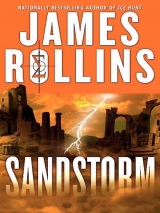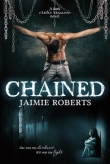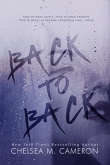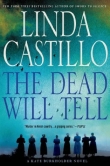
Текст книги "Sandstorm"
Автор книги: James Rollins
Жанр:
Триллеры
сообщить о нарушении
Текущая страница: 5 (всего у книги 31 страниц)
Samuelson was not stirred. “But its destruction also allowed this new discovery. There’s a balance in that. The same can’t be said for poor Harry Masterson.”
“Of course,” Safia said quickly. “I didn’t mean to imply that…his death was not the true tragedy. You’re most correct.”
Samuelson glanced around at those gathered. His eyes lingered a bit longer on the grad student, Clay Bishop. Whatever he saw there, he found wanting. His eyes drifted back to the statue. “You mentioned a tomb, near where this statue was found.”
“Yes. The tomb of Nabi Imran.”
“A pharaoh or something?”
Safia smiled. “This wasn’t an Egyptian tomb.” Like Kara, she knew the inspector was playing dumb. “In Arabia, the most famous tombs are those that mark the graves of people from the Bible or the Koran. In this case, a figure from both. ”
“Nabi Imran? I don’t recall that name from any Bible class.”
“Actually he was quite significant. You have heard of the Virgin Mary?”
“Vaguely.” He said this so sincerely he drew another smile from Safia.
She had been teasing out the revelation, but she finally relented. “Nabi Imran was Mary’s father.”
01:54 P.M. EST
ARLINGTON, VIRGINIA
PAINTER CROWE sat in the backseat of the silver Mercedes S500 sedan. It glided smoothly down Interstate 66 from Dulles International, heading east toward Washington, but they weren’t going that far. The driver, a taciturn fellow built like a linebacker, signaled and took the Glebe exit in Arlington. They were almost to DARPA headquarters, less than half a mile away.
He checked his watch. Only a couple hours ago he had been in Connecticut, confronting a partner he had trusted for the past five years. His thoughts shied away from Cassandra, but still circled around the sore subject.
They had been recruited out of Special Forces at the same time: he from the Navy SEALS, she from the Army Rangers. DARPA had chosen them for a new, highly secretive team within the organization, code-named Sigma Force. Most in DARPA were unaware of its existence. Sigma’s objective was search and seizure, a covert militarized team of technically trained agents who were sent into high-risk situations to obtain or protect new research and technologies. Where the Delta Force had been established as an antiterrorist squad, Sigma was started to protect and maintain the technological superiority of the United States.
No matter the cost.
And now this call back to headquarters.
It had to be a new mission. But why the urgency?
The sedan traveled down North Fairfax Drive and pulled into the parking lot. They ran a gauntlet of security measures and were soon sliding into an empty spot. Another man, barrel-chested and expressionless, stepped forward and opened the door.
“If you’ll follow me, Commander Crowe.”
Painter was led into the main building, escorted to the office suite of the director, and asked to wait while his attendant proceeded forward to announce his arrival. Painter stared at the closed door.
Vice Admiral Tony Rector had been the head of DARPA for as long as Painter had been in service there. Prior to that, he had been the head of the Office of Information Awareness, the intelligence-gathering wing of DARPA, critical after September 11 in monitoring data flowing across computer networks in search of terrorist plots, activities, and financial transactions. The admiral’s intelligence, expertise, and evenhanded management had eventually won him the directorship of DARPA.
The door opened. His escort waved him forward, stepping aside and allowing Painter to pass. Once he was through, the door closed behind him.
The room was paneled in dark mahogany and smelled vaguely of pipe tobacco. A matching mahogany desk stood in the center. Behind it, Tony “The Tiger” Rector rose to shake his hand. He was a large man, not fat, but someone who had once been well muscled now gone a little soft as he crossed his sixtieth year. But flesh was all that was soft about the man. His eyes were blue diamonds, his hair slicked and silver. His grip was iron as he shook Painter’s hand and nodded him to one of the two leather chairs.
“Have a seat. I’ve called up Dr. McKnight. He’ll be joining us.”
Dr. Sean McKnight was Sigma’s founder and director, Painter’s immediate superior, an ex-Navy SEAL who had gone on to earn a Ph.D. in both physics and information technology. If Dr. McKnight was being called in, then all the big boys were coming to play. Whatever was going down was significant.
“May I ask what this is in regard to, sir?”
The admiral settled into his own chair. “I heard about the bit of unpleasantness up in Connecticut,” he said, sidestepping the question. “The boys down in the Advanced Technology Office are waiting for that spy’s suitcase computer to be delivered. Hopefully, we’ll be able to retrieve the plasma weapons data from it.”
“I’m sorry we-I failed to obtain the password.”
Admiral Rector shrugged. “At least the Chinese won’t be getting their hands on it. And considering all you faced, you did a fine job up there.”
Painter held back asking about his former partner. Cassandra was most likely heading to a secure site to be interrogated. From there, who knew? Guantбnamo Bay, Fort Leavenworth, or some other military prison? It was no longer his concern. Still, an ache throbbed in his chest. He hoped it was only indigestion. He certainly had no reason to feel any pangs over Cassandra’s fate.
“As to your question,” the admiral continued, drawing him back to the moment, “something was brought to our attention by the Defense Sciences Office. There was an explosion over at the British Museum last night.”
Painter nodded, having listened to the news on CNN on the way here. “Lightning strike.”
“So it’s been reported.”
Painter heard the denial and sat straighter. Before he could inquire, the door opened. Dr. Sean McKnight strode into the room, a gale barely suppressed. His face was red, his brow damp, like he’d run all the way here.
“It’s been confirmed,” he said quickly to the admiral.
Admiral Rector nodded. “Take a seat, then. We don’t have much time.”
As his boss sat in the remaining leather chair, Painter glanced over. McKnight had worked with DARPA for twenty-two years, including a stint as the director of its Special Projects Office. One of his first “special projects” had been the formation of Sigma Force. He had envisioned a team of operatives who were both technologically savvy and militarily trained-“brains and brawn,” as he liked to say-who could operate with surgical precision to secure and protect classified technologies.
Sigma Force was the result.
Painter had been one of the first recruits, handpicked by McKnight after Painter had sustained a broken leg during a mission in Iraq. While he had been recuperating, McKnight had taught him the value of honing his mind as well as his body, putting him through an academic boot camp that was tougher than his BUDS training to become a Navy SEAL. There was no person on the planet whom Painter held in higher esteem.
And now to see him so shaken…
McKnight sat near the edge of his seat, back straight. It looked like he had slept in the charcoal suit he wore, appearing all his fifty-five years at the moment: his eyes crinkled with worry, lips tight, sandy gray hair uncombed.
Something was clearly wrong.
Admiral Rector swiveled a plasma monitor on his desk toward Painter. “Commander Crowe, you should view this footage first.”
Painter shifted closer, ready for some answers. The screen’s desktop filled with a black-and-white video.
“This is the security surveillance for the British Museum.”
He sat silently as the video rolled. A guard appeared on the screen, entering a museum gallery. It didn’t take long. As the explosion ended the tape, whiting out the screen, Painter sat back. His two superiors studied him.
“That luminous sphere,” he said slowly. “That was ball lightning, if I’m not mistaken.”
“Indeed,” Admiral Rector confirmed. “It was the same assessment that drew the attention of a pair of researchers with the Defense Sciences Office who were in London. Ball lightning has never been caught on film.”
“Or been that destructive,” Dr. McKnight added.
Painter recalled a lecture he’d heard during his Sigma Force training in electrical engineering. Ball lightning had been reported from the times of the early Greeks, seen by groups of people and reported in many places. Its rarity had kept it a mystery. Theories for its formation varied from free-floating plasma caused by the ionization of air during thunderstorms to the vaporization of silicon dioxide from the soil after lightning struck the ground.
“So what happened at the British Museum?” he asked.
“This.” Admiral Rector had removed an object from a desk drawer and placed it on his blotter. It looked like a blackened piece of rock, about the size of a softball. “We had it shipped on a military jet this morning.”
“What is it?”
The admiral nodded for him to pick it up. He did and found the object unusually heavy. Not rock. It felt dense enough to be lead.
“Meteoric iron,” Dr. McKnight explained. “A sample from the artifact that you saw explode a moment ago.”
Painter placed the chunk back on the desk. “I don’t understand. Are you saying the meteor caused the explosion? Not the ball lightning.”
“Yes and no,” McKnight answered cryptically.
“What do you know of the Tunguska explosion in Russia?” Rector asked.
The sudden shift in subject caught Painter off guard. His brow furrowed as he dredged up old history. “Not much. Something about a meteor strike, back in 1908, somewhere up in Siberia, caused a big blast.”
Rector leaned back. “ ‘Big’ is a bit of an understatement. The explosion uprooted a forest for forty miles around, over an area about half the size of Rhode Island. The blast liberated the energy equivalent of two thousand atomic bombs. Horses were knocked over four hundred miles away. Big just doesn’t quite cover the extent of the explosion.”
“There were other effects, too,” McKnight said. “A magnetic storm created a vortex for six hundred miles all around. For days afterward, the night skies were luminescent from the amount of dust, bright enough to read a newspaper by. An EM pulse wrapped itself halfway around the world.”
“Christ,” Painter mumbled.
“Those who witnessed the blast from hundreds of miles away reported seeing a streaking bright light in the sky, as brilliant as the sun, trailing a tail of iridescent colors.”
“The meteor,” Painter said.
Admiral Rector shook his head. “That was one theory. A stony asteroid or comet. But there are several problems with that theory. First, no meteor fragments have ever been found. Not even any telltale iridium dust.”
“Carbonaceous meteors usually leave an iridium fingerprint,” McKnight said. “But such a finding was never unearthed in Tunguska.”
“And there was no crater,” the admiral added.
McKnight nodded. “The force of the blast was forty megatons. Prior to that, the last meteor to even come close to such force struck Arizona some fifty thousand years ago. And it was only three megatons, a mere fraction of Tunguska, and it left a massive crater a mile wide and five hundred feet deep. So why no crater, especially when we so clearly know the epicenter of the blast due to the radial felling of the trees outward from ground zero?”
Painter had no answer to this…or to the more immediate question in his mind: What did any of this have to do with the British Museum?
McKnight continued. “Since the time of the explosion, there have also been interesting biological consequences noted in the region: an accelerated growth of certain ferns, an increase in the rate of mutations, including genetic abnormalities in the seeds and needles of pine trees and even ant populations. And humans have not escaped the effect. The local Evenk tribes in the area demonstrate abnormalities in their Rh blood factors. All clear indications of some radiological exposure, most likely gamma in origin.”
Painter tried to wrap his mind around a craterless explosion, unusual atmospheric effects, and residual gamma radiation. “So what caused all this?”
Admiral Rector answered, “Something quite small. About seven pounds.”
“That’s impossible,” he blurted.
The admiral shrugged. “If it was ordinary matter…”
The mystery hung in the air for a long moment.
Dr. McKnight finally spoke. “Newest research as of 1995 suggests that what struck Tunguska was indeed a meteor-but one composed of antimatter. ”
Painter’s eyes widened. “Antimatter?”
He now understood why he had been called into this briefing. While most folks considered antimatter to be the realm of science fiction, it had become reality in the past decade with the production of antimatter particles in laboratories. Leading the forefront in this research was CERN Laboratories in Geneva, Switzerland. The lab had been producing antimatter for close to two decades using a subterranean Low Energy Antiproton Ring. But to date, an entire year’s production of antiprotons by CERN would produce only enough energy to flicker a lightbulb for a few moments.
Still, antimatter was intriguing. A single gram of antimatter would produce the energy equivalent of an atomic bomb. Of course, someone would first have to discover a cheap, readily available source of antimatter. And that was impossible.
Painter found his eyes on the lump of meteoric iron resting atop Admiral Rector’s desk. He knew that the upper atmosphere of the Earth was under constant bombardment by antimatter particles in cosmic rays, but they were immediately annihilated when they came in contact with atmospheric matter. It had been postulated that there might be asteroids or comets in the vacuum of space composed of antimatter, left over from the Big Bang.
He began to connect some of the dots in his head. “The explosion at the British Museum…?”
“We’ve tested some of the debris from the blasted gallery,” McKnight said. “Metal and wood.”
Painter remembered his boss’s statement upon arriving here. It’s been confirmed. A cold lump formed in the pit of his belly.
McKnight continued, “The blast debris bears a low-level radiation signature that matches Tunguska.”
“Are you saying that the explosion at the British Museum was caused by antimatter annihilation? That that meteor is actually antimatter?”
Admiral Rector rolled the blasted fragment back and forth with a finger. “Of course not. This is ordinary meteoric iron. Nothing more.”
“Then I don’t understand.”
McKnight spoke up. “The radiation signature can’t be ignored. It’s too exact to be random. Something happened. The only explanation is that somehow the meteor had antimatter stored within it, in some unknown stabilized form. The electrical discharge by the ball lightning destabilized it and created a cascade effect with the resulting explosion. Whatever antimatter had been present was consumed during the blast.”
“Leaving only this shell behind,” the admiral said, nudging the stone.
Silence settled over the room. The implications were enormous.
Admiral Rector picked up the chunk of iron. “Can you imagine the significance if we’re right? A source of almost unlimited power. If there is some clue as to how this is possible-or better yet, a sample -it must not fall into other hands.”
Painter found himself nodding. “So what is the next step?”
Admiral Rector stared hard at him. “We can’t let word of this connection leak out, not even to our own allies. Too many ears are connected to too many mouths.” He nodded for Dr. McKnight to continue.
His boss took a deep breath. “Commander, we want you to lead a small team over to the museum. Your cover has already been established as American scientists specializing in lightning research. You’re to make contacts when and where you can. While there, your objective is simply to keep your ears to the ground and to note any new discoveries that might be made out there. We’ll continue research here with all departments mobilized. If any further investigation on site is needed in London, your team will be our go-to people.”
“Yes, sir.”
There was a flicker of eye contact between Admiral Rector and Dr. McKnight, an unspoken question.
Painter felt an icy finger trace his spine.
The admiral nodded again.
McKnight turned to face Painter. “There is one more factor here. We may not be the only ones working this angle.”
“What do you mean?”
“If you remember, the director mentioned a pair of researchers from the Defense Sciences Office over in London.”
“The ones who investigated the ball-lightning sighting.”
“Correct.” Again a flicker of contact between Painter’s two superiors. Then his boss fixed him with a hard stare. “Four hours ago, they were found shot, execution style, in their room. The place was ransacked. Several items were stolen. The Metropolitan Police are considering it a robbery homicide.”
Admiral Rector stirred behind his desk. “But I never could stomach coincidences. They give me heartburn.”
McKnight nodded. “We don’t know if the murders are connected to our line of investigation, but we want you and your team to proceed as if they were. Watch each other’s backs and keep alert.”
He nodded.
“In the meantime,” the admiral said, “let’s just hope they don’t discover anything significant out there until you get across the Pond.”
09:48 P.M. GMT
LONDON, ENGLAND
YOU HAVEto remove the heart.”
Safia glanced up from her measurements with a tiny silver caliper. The Arched Room of the museum lay dark all around. There were only the three of them left: Kara, Clay, and herself. Edgar and the inspector had left twenty minutes ago. It seemed the exacting measurements and notations of minutiae had not held their interest, diminishing the momentary wonder of the statue’s origin as a funerary sculpture for the tomb of the Virgin Mary’s father.
Safia returned to her measurements. “I’ll remove the heart eventually.”
“No, tonight. ”
Safia studied her friend closer. Kara’s face was limned in the halogen spots. The stark light bled all the color from her face, but Safia noted the silvery sheen to her skin, the wide cast to her pupils. She was high. Amphetamines again. Three years ago, Safia had been one of the few who had known Lady Kensington’s monthlong “vacation abroad” had actually been a trip through rehab in an exclusive private clinic down in Kent. How long had she been using again? She glanced to Clay. Now was not the time to confront her.
“What’s the hurry?” she asked instead.
Kara’s eyes darted around the room. Her voice lowered. “Before the inspector arrived, I noted something. I’m surprised you haven’t seen it yet.”
“What?”
Kara leaned over and pointed to one of the exposed sections of the heart, specifically the right ventricle. “Look at this raised line here.” She traced it with the tip of the caliper.
“One of the coronary arteries or veins,” Safia said, amazed at the artistry.
“Is it?” Kara pointed. “See how perfectly horizontal the top section is, then it drops down vertically at both ends at ninety degrees.” She followed the vessel’s course. Her fingers shook with a characteristic amphetamine tremor.

Kara continued, “Everything on this heart is so naturally rendered. Da Vinci would have a hard time being so anatomically precise.” She stared over to Safia. “Nature doesn’t like ninety-degree angles.”
Safia leaned closer. She traced the lines with her fingers, as if she were reading Braille. Doubt slowly faded to shock. “The ends…they simply stop abruptly. They don’t blend back down.”
“It’s a letter,” Kara said.
“Epigraphic South Arabian,” Safia agreed, naming the ancient script from the region, a script that predated Hebrew and Aramaic. “It’s the letter B. ”
“And look at what we can see of the upper heart chamber.”
“The right atrium,” Clay said behind them.
They both glanced at him.
“I was premed before I realized the sight of blood had such a…well, negative effect on what I had for lunch.”
Kara returned to the sculpture and pointed her caliper again. “A good portion of the upper atrium is still obscured by the sandstone encasement, but I think that’s another letter hidden under there.”
Safia leaned closer. She felt with her fingers. The tail end of exposed vessels ended abruptly as they did on the first one. “I’ll have to work carefully.”
She reached for the array of picks, chisels, and tiny hammers. With the proper tools in hand, she set about with the precision of a surgeon. Hammer and chisel to break away the larger chunks of brittle sandstone, then pick and brush to clear away. In a matter of minutes, the right atrium was cleared.
Safia stared down at the crisscrossing of what appeared to be coronary vessels. But they mapped out a perfect letter.

It was too complex for mere chance.
“What letter is that?” Clay asked.
“There’s not a direct corresponding letter in English,” Safia answered. “The letter is pronounced somewhat like the sound wa… so in translations it’s often listed W-A or even U, as that’s what it sounds like orally. Though in truth, there are no vowels in Epigraphic South Arabian script.”
Kara met her eyes. “We have to remove the heart,” she repeated. “If there are more letters, they’d be on the opposite side.”
Safia nodded. The left side still remained locked in the stone chest. She hated to disturb the statue any further, but curiosity drove her to pick up her tools without argument. She set to work. It took her a full half hour to remove the sandstone clamped around the heart. Finally, she attached the suction clamp and gripped the handle with both hands. With a prayer to the old gods of Arabia, she pulled evenly up, using all the muscles in her shoulders.
At first, it appeared to be stuck, but it was merely heavier than she had anticipated. With a determined grimace of effort, she lifted the heart free of the chest. Bits of sandstone and loose grains showered down. At arm’s length, she swung the prize around to the library table.
Kara hurried over to join them. Safia placed the heart on a square of soft leather chamois to protect it, then unfastened the suction clamp. The heart rolled slightly, once released. A small sloshing sound accompanied it.
Safia glanced at the others. Had they heard it, too?
“I told you I thought the thing was hollow,” Clay whispered.
Safia reached and rocked the heart on the chamois. The center of gravity rolled with the rocking. It reminded her oddly of one of those old Magic 8 Balls. “There’s some type of fluid in the center.”
Clay backed up a step. “Great, it had better not be blood. I prefer my cadavers desiccated and wrapped like mummies.”
“It’s sealed tight,” Safia assured him, examining the heart. “I can’t even spot a way to open it. It’s almost like the bronze heart was forged around it.”
“Riddles wrapped inside riddles,” Kara said, and took her turn rolling and checking the heart. “What about more lettering?”
Safia joined her. It took them half a moment to orient themselves and find the two remaining chambers. She ran her finger over the largest, the left ventricle. It was smooth and bare.
“Nothing,” Kara said, surprised and baffled. “Maybe it wore away.”
Safia checked more thoroughly, painting it with a bit of isopropyl alcohol to clean its surface. “I see no scoring or trace. It’s too smooth.”
“What about the left atrium?” Clay asked.
She nodded, turning the heart. She quickly spotted a line arcing cleanly over the face of the atrium.

“It’s the letter R, ” Kara whispered, sounding slightly frightened. She collapsed down on a chair. “It can’t be.”
Clay frowned. “I don’t understand. The letters B, WA or U, and R. What does it spell?”
“Those three ESA letters should be known to you, Mr. Bishop,” Safia said. “Maybe not in that order.” She picked up a pencil and drew them out as they should be spelled.

Clay scrunched his face. “ESA is read like Hebrew and Arabic, from right to left, opposite of English. WABR… UBR.But the vowels are excluded between consonants.” The young man’s eyes widened. “ U-B-A-RThe goddamn lost city of Arabia, the Atlantis of the sands.”
Kara shook her head. “First a meteorite fragment that was supposed to guard Ubar explodes…and now we find the name written on a bronze heart.”
“If it is bronze, ” Safia said, still bent over the heart.
Kara was shaken out of her shock. “What do you mean?”
Safia lifted the heart in her hands. “When I pulled the heart out of the statue, it seemed way too heavy, especially if it’s hollowed out and full of liquid. See where I cleaned the left ventricle with the alcohol? The base metal is much too red.”
Kara stood, understanding dawning in her eyes. “You think it’s iron. Like the meteorite fragment.”
Safia nodded. “Possibly even the same meteoric iron. I’ll have to test it, but either way it makes no sense. At the time of the sculpture’s carving, the peoples of Arabia didn’t know how to smelt and work iron of this quality, especially a masterful piece of art like this. There are so many mysteries here, I don’t even know where to begin.”
“If you’re right,” Kara said fiercely, “then that drab trading post unearthed in the desert back in 1992 is a far cry from the whole story. Something is yet undiscovered.” She pointed to the artifact. “Like the true heart of Ubar.”
“But what do we do now? What’s the next step? We’re no closer to knowing anything about Ubar.”
Clay was examining the heart. “It’s sort of strange that the left ventricle has no letters.”
“ ‘Ubar’ is only spelled with three letters,” Safia explained.
“Then why use a four-chambered heart and spell the letters in the direction of blood flow?”
Safia swung around. “Explain yourself?”
“Blood enters the heart from the body through the vena cava into the right atrium. The letter U. ” He poked a finger at the stumped large vessel that led to the right upper chamber and continued his anatomy lesson, tracing his way. “It then passes through the atrioventricular valve to the right ventricle. The letter B. From there, the blood leaves for the lungs via the pulmonary artery, then returns oxygen-rich through the pulmonary vein to the left atrium. The lette r R.Spelling out ‘Ubar.’ So why does it stop there?”
“Why indeed?” Safia mumbled, brow furrowed.
She pondered the mystery. The name Ubar was spelled in the path that blood traveled. It seemed to imply a direction, a flow toward something. A glimmer of an idea formed. “Where does the blood go after it leaves the heart?”
Clay pointed to a thick arched vessel at the very top. “Through the aorta to the brain and the rest of the body.”
Safia rolled the heavy heart, followed the aorta to where it ended, and stared inside the stump. A plug of sandstone was jammed in there. She had not bothered to clean it out, too busy concentrating on the surface of the chambers.
“What are you thinking?” Kara asked.
“It’s like the writing is pointing somewhere.” She returned the heart to the table and began to clean away the sandstone from the end of the aorta. It crumbled away easily. She sat back at what she found beyond the sand.
“What is that?” Clay asked, staring over her shoulder.
“Something prized more than blood itself by the ancient peoples of Arabia.” She used a pick to pry a few crystalline chunks of the dried resin onto the table. She could smell the sweet aroma given off by the crystals, preserved throughout the long centuries. It was a scent from a time before Christ.
“Frankincense,” Kara said, awe in her voice. “What does it mean?”
“It’s a signpost,” Safia answered. “As the blood flows, so do the riches of Ubar.” She turned to her friend. “The clue must point toward Ubar, to the next step on the road to its doorway.”
“But where does it point?” Kara asked.
Safia shook her head. “I’m not sure, but the town of Salalah is the beginning of the famous Incense Road.” She nudged the bits of crystalline frankincense. “And the tomb of Nabi Imran lies within that city.”
Kara straightened. “Then that’s where we must begin the search.”
“Search?”
“We must put an expedition together immediately.” Kara spoke rapidly, eyes wide. But it was not the amphetamines fueling her excitement. It was hope. “In a week’s time, no later. My contacts in Oman will make all the necessary arrangements. And we’ll need the best people. You, of course, and whomever you see fit.”
“Me?” Safia asked, her heart skipping a beat. “I…I’m not…I haven’t done fieldwork in years.”
“You’re going,” Kara said firmly. “It’s time for you to quit hiding in these dusty halls. Get back out in the world.”
“I can coordinate data from here. I’m not needed in the field.”
Kara stared at her, looking as if she was going to relent as she had in the past. Then her voice dropped to a husky whisper. “Saff, I need you. If something’s truly out there…an answer…” She shook her head, close to tears. “I need you with me. I can’t do it by myself.”
Safia swallowed, struggling with herself. How could she refuse her friend? She stared at the fear and hope in Kara’s eyes. But in her head, old screams still echoed. She could not silence them. Blood of children still stained her hands. “I…I can’t…”
Something must have broken in her face because Kara finally shook her head. “I understand.” But from her clipped tone, she didn’t. No one did.
Kara continued, “But you were right about one thing. We’ll need an experienced field archaeologist on board. And if you’re not going, I know the perfect person.”
Safia realized whom she meant. Oh, no…
Kara seemed to sense her distress. “You know he’s had the most field experience in the region.” She rummaged in her purse and pulled out her cellular phone. “If we’re going to succeed, we’re going to need Indiana Jones.”
4
White Water

NOVEMBER 15, 07:02 A.M.
YANGTZE RIVER, CHINA
I’M NOT Indiana Jones!” he yelled into the satellite phone’s headset to be heard over the jet boat’s motor. “Name’s Omaha…Dr. Omaha Dunn! Kara, you know that!”
An exasperated sigh answered him. “Omaha? Indiana? What bloody difference does it make? All your American names sound the same.”
He crouched over the wheel, racing down the crooked river gorge. Cliffs flanked both sides of the muddy Yangtze as it twisted and turned through a section aptly named the Narrows. In a few years, Three Gorges Dam would flood this entire region to the tranquil depth of two hundred feet, but for now, submerged rocks and wicked rapids remained a constant danger as the fierce river choked through the squeeze.








